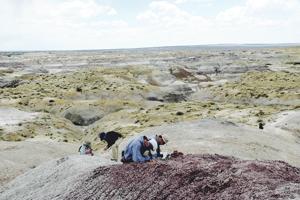A team of researchers, led by Andrew Flynn from New Mexico State University, has made significant strides in understanding the mass extinction event that eradicated the dinosaurs approximately 66 million years ago. Their findings, published on October 23, 2023, in the journal Science, focus on the last non-avian dinosaurs that thrived in the San Juan Basin near Farmington, New Mexico.
Flynn’s research, begun during his Ph.D. studies at Baylor University, reveals that the dinosaurs from the Naashoibito member in the De-Na-Zin Wilderness Area were not in decline before the catastrophic asteroid impact. Instead, these creatures were part of vibrant ecosystems, showcasing a diversity that challenges previous assumptions about the state of dinosaurs leading up to their extinction.
New Insights into Dinosaur Diversity
The study identifies the dominant dinosaur species in this region as the large sauropod, Alamosaurus. Measuring approximately the length of two semi-tractor trailers and weighing between 30 to 80 tons, this dinosaur stood about 30 to 50 feet tall. Unlike the well-known dinosaur communities from the Hell Creek Formation in Montana and North Dakota, which feature species like Triceratops and Edmontosaurus, the New Mexican fauna presents a unique composition.
According to co-author Dan Peppe, a professor of geosciences at Baylor, the new evidence demonstrates that the Naashoibito dinosaurs coexisted with those from the Hell Creek region during the late Cretaceous period. “These were vibrant, diverse communities,” he noted, highlighting that they were thriving rather than declining.
Flynn elaborated on the implications of their research, stating, “What our new research shows is that dinosaurs are not on their way out going into the mass extinction. They’re doing great, they’re thriving, and the asteroid impact seems to knock them out.” This finding contradicts a long-held belief that there was a gradual decline in dinosaur diversity prior to the extinction event.
Examining the Aftermath of Extinction
Another pivotal conclusion of the research indicates that, following the extinction event, mammals retained distinct northern and southern biogeographic provinces. This is noteworthy because, in past mass extinctions, the resulting mammalian communities tended to be more uniform across regions.
The researchers utilized magnetic field reversals to date the rock layers where the dinosaur fossils were found. This innovative approach allowed them to establish that the fossils from New Mexico were contemporaneous with those from the Hell Creek Formation. This alignment of ages provides critical context for understanding the last days of these prehistoric creatures.
Steve Brusatte, a professor of paleontology and evolution at the University of Edinburgh, emphasized the significance of these findings. “Now, in New Mexico, we have fossils of dinosaurs that were there right at the end. These were the dinosaurs that were greeted by the asteroid,” he stated. The ability to compare these fossils with others accurately dated from the same period underscores the diverse ecosystems that existed just before the impact.
Flynn’s ongoing research aims to uncover fossil plants from the Naashoibito member to further enrich the understanding of the ecological changes that occurred before and after the extinction. “Finding the fossil plants there would allow us to show how different the flora was before and after the extinction in New Mexico,” he explained, highlighting a crucial next step in this significant research endeavor.
As the team continues to explore the paleontological landscape of New Mexico, their work not only illuminates the rich diversity of late Cretaceous dinosaurs but also reshapes the narrative surrounding one of Earth’s most significant extinction events.







